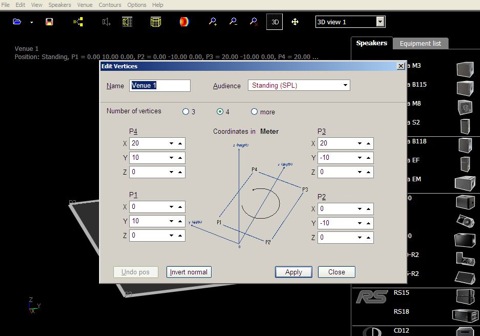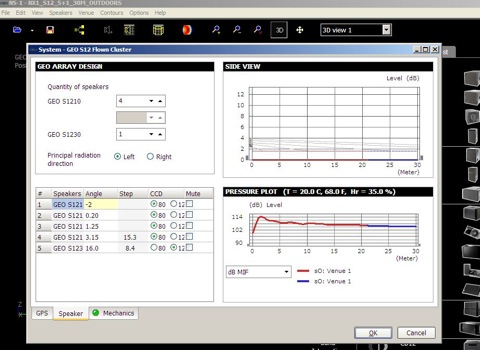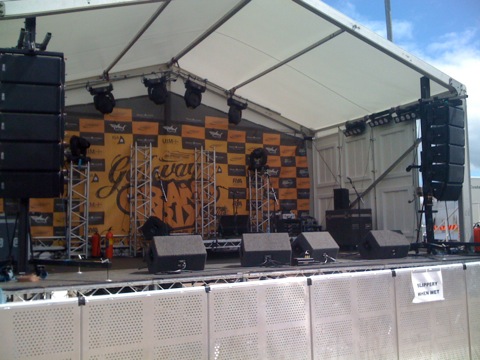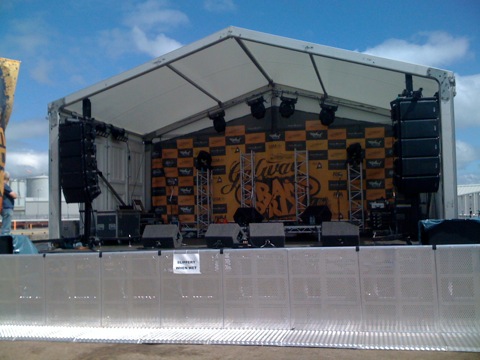New Hire Inventory
05/03/11 07:59 Filed in: Press & Media Release | Nexo PA Systems
We've recently added a large number of Nexo PS10R2 speakers to out hire inventory. These are suitable as a high powered speaker on stand system, or as a good compact stage monitor. They also dove-tail well as front fills for our GEO S12 systems.
The PS10R2 is a significant upgrade on the original PS10, itself an amazing compact speaker. They come as standard as left and right pairs, with integrated flying points for use with PS/GEO S12 rigging equipment. The NXAMP now contains DSP for the use of the speaker as a monitor as well as standard FOH duties. In common with the predecessor, the PS10R2 has a rotatable horn for FOH or monitor applications.
We've also added some more RS15 subs and S1210's to our stock of Nexo GEO S12 system. So in the week just ended we were able to service theatre venue seating 750 at one end of the country as well as a stand up hip-hop gig for 900 at the other.
We've also made the long-term rental of a second SC48 from SSE Audio permanent as well as adding some more SSE MB4 monitors to our existing inventory.
The PS10R2 is a significant upgrade on the original PS10, itself an amazing compact speaker. They come as standard as left and right pairs, with integrated flying points for use with PS/GEO S12 rigging equipment. The NXAMP now contains DSP for the use of the speaker as a monitor as well as standard FOH duties. In common with the predecessor, the PS10R2 has a rotatable horn for FOH or monitor applications.
We've also added some more RS15 subs and S1210's to our stock of Nexo GEO S12 system. So in the week just ended we were able to service theatre venue seating 750 at one end of the country as well as a stand up hip-hop gig for 900 at the other.
We've also made the long-term rental of a second SC48 from SSE Audio permanent as well as adding some more SSE MB4 monitors to our existing inventory.
0 Comments
Druid Theatre Company Purchase Nexo/Yamaha Touring system
Galway theatre company, Druid, have recently completed the purchase of a Nexo PS10R2 touring system from Alex Fernie Audio Ltd. The purchase, which includes Yamaha/Nexo NXAMPs, a Yamaha LS9-16 with MY16AT card as well as cable looms and line systems from Van Damme, will form the backbone of their touring audio system.
Having being a regular hirer of PS10 and Nexo systems from Alex Fernie Audio Ltd since 2005, it made sense for the company to invest in the new PS10R2. Druid Theatre are currently en route to the US, where "The Cripple of Inishmaan" will tour for the next five months. 2011 promises to be a busy one again for the theatre company, with new productions in the pipeline for the second half of the year.
The combination of the Yamaha LS9-16 with MY16AT card and an Echo Audio AudioFire12 will allow the company to run the sound for shows from a Apple Mac running Qlab Pro via MIDI as they have been doing for the past 2 years. The AudioFire12 is a 12in/12out firewire interface.
The purchase also includes a range of flightcases for amplifiers, consoles, cable and speakers.
Druid have also purchased some EV ZX1's, amplification and microphones for their redeveloped theatre space which, when not in use by Druid, is available to hire for theatre shows, as a rehearsal space or as a venue for press-calls or media receptions.
www.druidtheatre.com
www.nexo-sa.com
www.yamahaproaudio.com
www.echoaudio.com
Having being a regular hirer of PS10 and Nexo systems from Alex Fernie Audio Ltd since 2005, it made sense for the company to invest in the new PS10R2. Druid Theatre are currently en route to the US, where "The Cripple of Inishmaan" will tour for the next five months. 2011 promises to be a busy one again for the theatre company, with new productions in the pipeline for the second half of the year.
The combination of the Yamaha LS9-16 with MY16AT card and an Echo Audio AudioFire12 will allow the company to run the sound for shows from a Apple Mac running Qlab Pro via MIDI as they have been doing for the past 2 years. The AudioFire12 is a 12in/12out firewire interface.
The purchase also includes a range of flightcases for amplifiers, consoles, cable and speakers.
Druid have also purchased some EV ZX1's, amplification and microphones for their redeveloped theatre space which, when not in use by Druid, is available to hire for theatre shows, as a rehearsal space or as a venue for press-calls or media receptions.
www.druidtheatre.com
www.nexo-sa.com
www.yamahaproaudio.com
www.echoaudio.com
List Hire Prices
18/10/10 13:59 Filed in: General
I’ve noticed a few searches on our website for hire prices. Generally we don’t publish these prices as overall package prices vary with quantity, hire duration as well as the competitive discount structure we offer our long-term customers.
Below then is are the list prices for individual items in our inventory. All prices are Ex VAT of 21% and are prices for a one day hire.
For best prices, please call or email and ask for a quotation.
Speakers (Includes stands, rigging and cable as required)
Nexo RS15 €55
Nexo S1210/S1230 €55
Nexo PS10 €25
Nexo LS500 €25
SSE MB4 monitor €15
QSC K10 active speaker (2 mic/line input) €50
Amplifiers
NXAMP 4x4 €45
NXAMP 4x1 €35
Camco Vortex 4 €25
Consoles
Digidesign/Avid Venue SC48 €200.00
Yamaha LS9 16 €80.00
Microphones/DI Boxes (all include cable & stand as necessary)
Shure SM58/SM57 €5.00
Shure Beta 58/Beta 57 €7.50
Shure SM81 €10.00
Shure Beta 52 €7.50
Shure Beta 98 €15
AKG 214 €10
Sennheiser e604 €5
Sennheiser e904 €7.50
Sennheiser e906 €7.50
Sennheiser MD241 €10.00
Neumann KM184 €35.00
BSS AR133 Active DI Box €5.00
EMO Passive DI box €2.50
Wireless Microphone Systems
Sennheiser EW100 G3 with handheld or beltpack transmitter €35
Below then is are the list prices for individual items in our inventory. All prices are Ex VAT of 21% and are prices for a one day hire.
For best prices, please call or email and ask for a quotation.
Speakers (Includes stands, rigging and cable as required)
Nexo RS15 €55
Nexo S1210/S1230 €55
Nexo PS10 €25
Nexo LS500 €25
SSE MB4 monitor €15
QSC K10 active speaker (2 mic/line input) €50
Amplifiers
NXAMP 4x4 €45
NXAMP 4x1 €35
Camco Vortex 4 €25
Consoles
Digidesign/Avid Venue SC48 €200.00
Yamaha LS9 16 €80.00
Microphones/DI Boxes (all include cable & stand as necessary)
Shure SM58/SM57 €5.00
Shure Beta 58/Beta 57 €7.50
Shure SM81 €10.00
Shure Beta 52 €7.50
Shure Beta 98 €15
AKG 214 €10
Sennheiser e604 €5
Sennheiser e904 €7.50
Sennheiser e906 €7.50
Sennheiser MD241 €10.00
Neumann KM184 €35.00
BSS AR133 Active DI Box €5.00
EMO Passive DI box €2.50
Wireless Microphone Systems
Sennheiser EW100 G3 with handheld or beltpack transmitter €35
Designing a Nexo Tangent array
13/10/10 11:11 Filed in: Nexo PA Systems
A Note to Professionals: This piece is aimed at the non-professional user in an effort to explain, in layman’s terms, the science and procedure for rigging and tuning a high performance PA system. It is written to show potential clients that there is a difference between the same speaker systems if they are badly designed or deployed. Therefore, there will be some details abbreviated, simplified or omitted for clarity.
Setting up a PA system is easy right? Put the speakers on stands, face them at the audience as you would with your home stereo and you’re good to go, right. Well yes, sort of. The problems arise when you put multiple speakers together in a room in order to cater for larger audiences. If not properly designed, large PA systems can affect tone and clarity as well as having differing tonal characteristics in different parts of a room.
At Alex Fernie Audio, the design of the system begins before we even load the truck. Firstly, the room is measured by a human using a laser measure. We measure the length, width and height of a venue. We measure the width of the stage and the distance from the first line of the audience to the stage. Luckily, over the years we have built up a database of these dimensions for most of the main venues in Ireland, but for new or unfamiliar venues, we look for architectural drawings or send someone to take these measurements for us.
For our Nexo systems, we use Nexo’s proprietary design and prediction software NS-1. Firstly, we tell the program the venue dimensions. As you can see, we work along all 3 dimensions to give a 3-D picture.

As you can see from the picture above, the room we are looking at is a 20 metre by 20 metre square. The Z axis allows us to factor in any slope in the room, to take account of seating banks or balconies. In this room the room is a flat open space.
Next, we open the speaker selection dialogue box and begin adding speakers:

This is the most important part. Here, we not only calculate the quantity and type of speaker we will use, but also the exact position of the speaker in the room (the GPS tab at the bottom) and the angles between each speaker cabinet. On the left of the dialogue box above, we see the speaker type and the various angles between each box. To the right, we see a guide to where each individual speaker is aimed and the lower diagram shows how the speaker system is performing. The basic idea is to design a system which is as loud at the front as it is at the back. This is done for all speaker systems, i.e. left and right and also for the sub-bass cabinets underneath the main PA.
The “mechanics” tab at the bottom of the speaker selection dialogue box ensures that the rigging we are using will be safe and mechanically possible. It tells us how many speakers we will be packing and how heavy the system will be (this is important for the guys rigging the PA on the day) as well as how far it will be above the audience’s heads and so on. As most of our large PA systems are flown on chain hoists from the ceiling of a building, we need to make sure the roof can take the weight. If not we must look at other options such as our own PA lifting towers. For outdoor gigs, we can add in the effect of wind to ensure the system is safe in normal conditions.

Finally, we do a prediction check to see how the system will perform at the day. The software makes a prediction based on average sound levels using pink noise.

This is useful advance information for the system technician on the day when he makes his tweaks to the system on the day. Essentially the coverage is fairly even throughout the venue, however he may decide to angle the speaker arrays as he listens to the system in the room. NS-1 software gives us advance knowledge of potential issues on the day so speeding up the deployment process as well as ensuring we have enough boxes to cover the room.
So there you have it. When you call us up to enquire about a PA system, this is how we work out how many speakers we need, how many people we need to rig the system and ultimately how much it will cost you, the customer.
Setting up a PA system is easy right? Put the speakers on stands, face them at the audience as you would with your home stereo and you’re good to go, right. Well yes, sort of. The problems arise when you put multiple speakers together in a room in order to cater for larger audiences. If not properly designed, large PA systems can affect tone and clarity as well as having differing tonal characteristics in different parts of a room.
At Alex Fernie Audio, the design of the system begins before we even load the truck. Firstly, the room is measured by a human using a laser measure. We measure the length, width and height of a venue. We measure the width of the stage and the distance from the first line of the audience to the stage. Luckily, over the years we have built up a database of these dimensions for most of the main venues in Ireland, but for new or unfamiliar venues, we look for architectural drawings or send someone to take these measurements for us.
For our Nexo systems, we use Nexo’s proprietary design and prediction software NS-1. Firstly, we tell the program the venue dimensions. As you can see, we work along all 3 dimensions to give a 3-D picture.

As you can see from the picture above, the room we are looking at is a 20 metre by 20 metre square. The Z axis allows us to factor in any slope in the room, to take account of seating banks or balconies. In this room the room is a flat open space.
Next, we open the speaker selection dialogue box and begin adding speakers:

This is the most important part. Here, we not only calculate the quantity and type of speaker we will use, but also the exact position of the speaker in the room (the GPS tab at the bottom) and the angles between each speaker cabinet. On the left of the dialogue box above, we see the speaker type and the various angles between each box. To the right, we see a guide to where each individual speaker is aimed and the lower diagram shows how the speaker system is performing. The basic idea is to design a system which is as loud at the front as it is at the back. This is done for all speaker systems, i.e. left and right and also for the sub-bass cabinets underneath the main PA.
The “mechanics” tab at the bottom of the speaker selection dialogue box ensures that the rigging we are using will be safe and mechanically possible. It tells us how many speakers we will be packing and how heavy the system will be (this is important for the guys rigging the PA on the day) as well as how far it will be above the audience’s heads and so on. As most of our large PA systems are flown on chain hoists from the ceiling of a building, we need to make sure the roof can take the weight. If not we must look at other options such as our own PA lifting towers. For outdoor gigs, we can add in the effect of wind to ensure the system is safe in normal conditions.

Finally, we do a prediction check to see how the system will perform at the day. The software makes a prediction based on average sound levels using pink noise.

This is useful advance information for the system technician on the day when he makes his tweaks to the system on the day. Essentially the coverage is fairly even throughout the venue, however he may decide to angle the speaker arrays as he listens to the system in the room. NS-1 software gives us advance knowledge of potential issues on the day so speeding up the deployment process as well as ensuring we have enough boxes to cover the room.
So there you have it. When you call us up to enquire about a PA system, this is how we work out how many speakers we need, how many people we need to rig the system and ultimately how much it will cost you, the customer.
Subwoofer arrays, new Nexo RS18 and a letter to Mr. Band Sound Engineer.
Just a short link to an article on building sufwoofer arrays, printed in this months Live Sound International. Quite Meyer specific, but some good info here. Don’t take all of it as gospel, though. There has been some talk over at Prosoundweb about erroneous information going unchecked in the mag, so this is just a disclaimer as I haven’t read this article in detail yet.
Speaking of subs, Nexo are demoing their new RS18 sub in Frankfurt next week. More info here. Will miss it unfortunately due to the work commitments here
Oh yeah and while I think of it:
Mr band sound engineer, next time you want an extra 3db across your mains and I’m supplying the PA, just ask - I generally oblige. Don’t say all’s cool and you’re happy and then do it on the sly just before your set. Password protection will be making a comeback....
Speaking of subs, Nexo are demoing their new RS18 sub in Frankfurt next week. More info here. Will miss it unfortunately due to the work commitments here
Oh yeah and while I think of it:
Mr band sound engineer, next time you want an extra 3db across your mains and I’m supplying the PA, just ask - I generally oblige. Don’t say all’s cool and you’re happy and then do it on the sly just before your set. Password protection will be making a comeback....
2010 Sound Support Scheme
22/01/10 14:06 Filed in: Blog
I’ve been working away at this for the past few weeks so it’s great to finally put it out into the world and see what happens.
The idea came to me driving home from a gig one night around Christmas. Wouldn’t it be great if bands, venue owners and promoters could fix their audio costs for a year like they fix any other cost? And spread the payments for the year over a few months? Insurance costs, rent and vehicle costs are fixed for a year, why can’t we do the same with audio hire.
Say your band does 35 gigs a year and you are based in Dublin. You might pay one rate for PA hire and crew in Dublin but once you go elsewhere in the country for gigs, you end up maybe hiring from another local company and paying a bit less. But the gear is different and you aren’t sure what you will end up with on the night. So... you decide to rent from your regular Dublin PA company but they have to charge more than usual to drive to wherever the gig is. So some nights you pay €400 and some nights you pay maybe €600 for PA and crew. But you still get the same fee for playing in Dublin as you do in Kerry. You can see where this is heading....
Or say you have a venue where you put on gigs 20 times a year. You want the same PA system for these of these 20 gigs but you can’t afford to buy it. So you rent it in for each gig. But maybe one or two gigs don’t sell so well and you lose money on the night. What if you could spread the annual payments over 7 months, giving you some cover for shows that don’t do so well on the door and letting you make a killing on the busy nights
Or you run a 3 day festival once a year and a few shows around Ireland for the rest of the year. After a festival everyone wants to get paid. The bands, the lighting and sound companies, the stage company, security, advertising company, the portaloo guy etc etc etc. But you’re waiting on the money from the ticket sales and the concessions to come in and we know how long that takes. What if you could spread the PA cost over 7 months? Would that help?
The Sound Support Scheme provides a solution to all these problems.
You get a fixed price for an agreed specification. The crew costs and transport costs to anywhere in Ireland are all included. You pay an upfront fee of 25% and then 6 equal monthly payments.
So if you’re a band playing around the country, you pay the same cost for a gig in Donegal as a gig in Cork. If you start the scheme in say April, by November you’ve paid for the PA. And that means that you pocket all the money from the gigs from December until March but you still have a PA system.
For any more info, have a read of the Sound Support page on the website or contact me for more information

The idea came to me driving home from a gig one night around Christmas. Wouldn’t it be great if bands, venue owners and promoters could fix their audio costs for a year like they fix any other cost? And spread the payments for the year over a few months? Insurance costs, rent and vehicle costs are fixed for a year, why can’t we do the same with audio hire.
Say your band does 35 gigs a year and you are based in Dublin. You might pay one rate for PA hire and crew in Dublin but once you go elsewhere in the country for gigs, you end up maybe hiring from another local company and paying a bit less. But the gear is different and you aren’t sure what you will end up with on the night. So... you decide to rent from your regular Dublin PA company but they have to charge more than usual to drive to wherever the gig is. So some nights you pay €400 and some nights you pay maybe €600 for PA and crew. But you still get the same fee for playing in Dublin as you do in Kerry. You can see where this is heading....
Or say you have a venue where you put on gigs 20 times a year. You want the same PA system for these of these 20 gigs but you can’t afford to buy it. So you rent it in for each gig. But maybe one or two gigs don’t sell so well and you lose money on the night. What if you could spread the annual payments over 7 months, giving you some cover for shows that don’t do so well on the door and letting you make a killing on the busy nights
Or you run a 3 day festival once a year and a few shows around Ireland for the rest of the year. After a festival everyone wants to get paid. The bands, the lighting and sound companies, the stage company, security, advertising company, the portaloo guy etc etc etc. But you’re waiting on the money from the ticket sales and the concessions to come in and we know how long that takes. What if you could spread the PA cost over 7 months? Would that help?
The Sound Support Scheme provides a solution to all these problems.
You get a fixed price for an agreed specification. The crew costs and transport costs to anywhere in Ireland are all included. You pay an upfront fee of 25% and then 6 equal monthly payments.
So if you’re a band playing around the country, you pay the same cost for a gig in Donegal as a gig in Cork. If you start the scheme in say April, by November you’ve paid for the PA. And that means that you pocket all the money from the gigs from December until March but you still have a PA system.
For any more info, have a read of the Sound Support page on the website or contact me for more information



